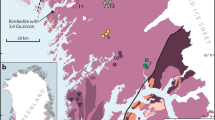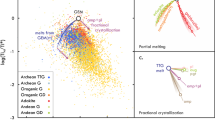Abstract
Application of the 147Sm–143Nd and 146Sm–142Nd chronometers has suggested that the initial differentiation of Earth’s mantle into enriched and depleted reservoirs may have begun within the first 100–200 million years of Earth’s history1. However, little is known about the differentiation of the early crust; although evidence has suggested the presence of enriched crustal material2,3,4,5, data regarding the nature and composition of this crust are limited. Here we present 147Sm–143Nd data from the weakly metamorphosed basalt and layered chert–barite successions from the Dresser Formation of the Pilbara Craton, Western Australia. The Sm–Nd isochron indicates an age of 3.49±0.10 billion years, in agreement with previous estimates from Pb–Pb (ref. 6) and U–Pb (ref. 7) dating, which indicates that the Sm–Nd system has not been reset. Our measured ɛNd value of −3.3±1.0 for the rocks at this site is consistent with formation from an older protolith. On the basis of our modelling of trace element and isotopic compositions from these rocks, we suggest that the older component was crustal in nature, and differentiated from the convective mantle more than 4.3 billion years ago.
This is a preview of subscription content, access via your institution
Access options
Subscribe to this journal
Receive 12 print issues and online access
$259.00 per year
only $21.58 per issue
Buy this article
- Purchase on Springer Link
- Instant access to full article PDF
Prices may be subject to local taxes which are calculated during checkout



Similar content being viewed by others
References
Caro, G., Bourdon, B., Birck, J.-L. & Moorbath, S. High-precision 142Nd/144Nd measurements in terrestrial rocks: Constraints on the Early differentiation of the Earth’s mantle. Geochim. Cosmochim. Acta 70, 164–191 (2006).
Kamber, B. S., Collerson, K. D., Moorbath, S. & Whitehouse, M. Inheritance of early Archean Pb-isotope variability from long-lived Hadean protocrust. Contrib. Mineral. Petrol. 145, 25–26 (2003).
Mojzsis, S. J., Harrison, T. M. & Pidgeon, R. T. Oxygen-isotope evidence from ancient zircons for liquid water at the Earth’s surface 4,300 Myr ago. Nature 409, 178–181 (2001).
O’Neil, J. R., Carlson, R. W., Francis, D. & Stevenson, R. K. Neodymium-142 evidence for Hadean mafic crust. Science 321, 1828–1831 (2008).
Upadhyay, D., Scherer, E. E. & Mezger, K. 142Nd evidence for an enriched Hadean reservoir in cratonic roots. Nature 459, 1118–1120 (2009).
Thorpe, R. I., Hickman, A. H., Davis, D. W., Moretnsen, J. K. & Trendall, A. F. in The Archaean: Terrains, Processes and Metallogeny Vol. 22 (eds Glover, J. E. & Ho, S. E.) 395–408 (Geology Department and University Extension, Univ. Western Australia Publication, 1992).
Van Kranendonk, M., Philippot, P., Lepot, K., Bodorokos, S. & Pirajno, F. Geological setting of Earth’s oldest fossils in the c. 3.5 Ga Dresser Formation, Pilbara Craton, Western Australia. Precambr. Res. 167, 93–124 (2008).
Buick, R. & Dunlop, J. S. R. Evaporitic sediments of early Archaean age from the Warrawoona Group, North Pole, Western Australia. Sedimentology 37, 247–277 (1990).
Nijman, W., De Bruijne, K. C. H. & Valkering, M. E. Growth fault control of early Archaean cherts, barite mounds and chert–barite veins, North Pole Dome, eastern Pilbara, Western Australia. Precambr. Res. 88, 25–52 (1998).
Van Kranendonk, M. J. Volcanic degassing, hydrothermal circulation and the flourishing of early life on Earth: A review of the evidence from c. 3490-3240 Ma rocks of the Pilbara Supergroup, Pilbara Craton, Western Australia. Earth-Sci. Rev. 74, 197–240 (2006).
Kato, Y. & Makamura, K. Origin and global tectonic significance of Early Archean cherts from the Marble Bar greenstone belt, Pilbara Craton, Western Australia. Precambr. Res. 125, 191–243 (2003).
Barley, M. E. Volcanic, sedimentary and tectonostratigraphic environments of the ∼3.46 Gyr Warrawoona Megasequence: A review. Precambr. Res. 60, 47–67 (1993).
Condie, K. C. Plate Tectonics and Crustal Evolution (Butterworth-Heinemann, 1997).
Green, M. G., Sylvester, P. J. & Buick, R. Growth and recycling of Early Archaean continental crust: Geochemical evidence from the Coonterunah and Warrawoona Groups, Pilbara Craton, Australia. Tectonophysics 322, 69–88 (2000).
Van Kranendonk, M., Hickman, A. H. & Smithies, R. H. in Earth’s Oldest Rocks Vol. 15 (eds Van Kranendonk, M. J., Smithies, R. H. & Bennet, V.) 307–337 (Elsevier, 2007).
Smithies, R. H., Champion, D. C. & Van Kranendonk, M. Formation of Paleoarchean continental crust through infracrustal melting of enriched basalt. Earth Planet. Sci. Lett. 281, 298–306 (2009).
Bickle, M. J. A 3500 Ma plutonic and volcanic calc-alkaline province in the Archaean East Pilbara Block. Contrib. Mineral. Petrol. 84, 25–35 (1983).
Philippot, P. et al. Drilling Archean stratigraphic horizons: Pilbara Craton, Western Australia and Barberton Belt, South Africa. C. R. Palevol 8, 649–663 (2009).
Buick, R. et al. Record of emergent continental crust approximately 3.5 billion years ago in the Pilbara Craton of Australia. Nature 375, 574–577 (1995).
Polat, A., Hofmann, A. W., Münker, C., Regelous, M. & Appel, P. W. U. Contrasting geochemical patterns in the 3.7–3.8 Gyr pillow basalt cores and rims, Isua greenstone belt, Southwest Greenland: Implications for postmagmatic alteration processes. Geochim. Cosmochim. Acta 67, 441–457 (2003).
Condie, K. C. Chemical composition and evolution of the upper continental crust: Contrasting results from surface samples and shales. Chem. Geol. 104, 1–37 (1993).
Collerson, K. D. & Kamber, B. S. Evolution of the continents and the atmosphere inferred from Th–U–Nb systematics of the depleted mantle. Science 283, 1519–1522 (1999).
Hofmann, A. W., Jochum, K. P., Seufert, H. M. & White, W. M. Nb and Pb in oceanic basalts: New constraints on mantle evolution. Earth Planet. Sci. Lett. 79, 33–45 (1986).
Mojzsis, S. J., Harrison, T. M. & Pidgeon, R. T. Oxygen-isotope evidence from ancient zircons for liquid water at the Earth’s surface 4,300 Myr ago. Nature 409, 178–181 (2001).
Wilde, S. A., Valley, J. W., Peck, W. H. & Graham, C. M. Evidence from detrital zircons for the existence of continental crust and oceans on the Earth 4.4 Gyr ago. Nature 409, 175–178 (2001).
Mills, R. A. & Elderfield, H. Rare earth element geochemistry of hydrothermal deposits from the active TAG Mound, 26∘N Mid-Atlantic Ridge. Geochim. Cosmochim. Acta 59, 3511–3524 (1995).
Goldstein, S. J. & Jacobsen, S. B. Nd and Sr isotopic systematics of river water suspended material: Implications for crustal evolution. Earth Planet. Sci. Lett. 87, 249–265 (1988).
Moorbath, S., Whitehouse, M. & Kamber, B. S. Extreme Nd-isotope heterogeneity in the Early Archaean—fact or fiction? Case histories from northern Canada and West Greenland. Chem. Geol. 135, 213–231 (1997).
Acknowledgements
We thank the Institut de Physique du Globe de Paris, the Institut des Sciences de l’Univers (INSU) and the Geological Survey of Western Australia for supporting the Pilbara Drilling Project. P.P. acknowledges financial support from the Agence Nationale de la Recherche (ANR-Blanc). S.T. acknowledges support of a Centre National de la Recherche Scientifique (CNRS) postdoctoral position. This is IPGP contribution number 2578.
Author information
Authors and Affiliations
Contributions
S.G.T., B.B., M.V.K. and P.P. contributed equally to this work. P.P. and M.V.K. contributed to the field work and characterization of samples. S.G.T. carried out the analytical work with assistance from J-L.B. S.G.T., P.P., B.B. and M.V.K. wrote the paper. All authors discussed the results and commented on the manuscript.
Corresponding author
Ethics declarations
Competing interests
The authors declare no competing financial interests.
Supplementary information
Supplementary Information
Supplementary Information (PDF 796 kb)
Rights and permissions
About this article
Cite this article
Tessalina, S., Bourdon, B., Van Kranendonk, M. et al. Influence of Hadean crust evident in basalts and cherts from the Pilbara Craton. Nature Geosci 3, 214–217 (2010). https://doi.org/10.1038/ngeo772
Received:
Accepted:
Published:
Issue Date:
DOI: https://doi.org/10.1038/ngeo772
This article is cited by
-
The age, metal source and genesis of the Nifty copper deposit in the context of the geological evolution of the Paterson Province, Western Australia
Mineralium Deposita (2020)
-
The Emergence of Life
Space Science Reviews (2019)
-
Evidence of Enriched, Hadean Mantle Reservoir from 4.2-4.0 Ga zircon xenocrysts from Paleoarchean TTGs of the Singhbhum Craton, Eastern India
Scientific Reports (2018)
-
Geochemical constraints on the Hadean environment from mineral fingerprints of prokaryotes
Scientific Reports (2017)
-
Argon isotopic composition of Archaean atmosphere probes early Earth geodynamics
Nature (2013)



